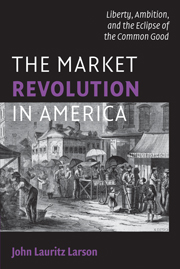Book contents
- Frontmatter
- Contents
- Acknowledgments
- Introduction: What Do We Mean by a Market Revolution in America?
- 1 First Fruits of Independence
- Interlude: Panic! 1819
- 2 Marvelous Improvements Everywhere
- Interlude: Panic! 1837
- 3 Heartless Markets, Heartless Men
- 4 How Can We Explain It?
- Epilogue: Panic! 2008, Déjà vu All over Again
- An Essay on the Sources
- Index
1 - First Fruits of Independence
Published online by Cambridge University Press: 05 June 2012
- Frontmatter
- Contents
- Acknowledgments
- Introduction: What Do We Mean by a Market Revolution in America?
- 1 First Fruits of Independence
- Interlude: Panic! 1819
- 2 Marvelous Improvements Everywhere
- Interlude: Panic! 1837
- 3 Heartless Markets, Heartless Men
- 4 How Can We Explain It?
- Epilogue: Panic! 2008, Déjà vu All over Again
- An Essay on the Sources
- Index
Summary
With political independence secured under the Treaty of Paris (1783), the American founders in the states and in the Union sought to restart a war-torn economy and find their way back into the Atlantic commercial networks. At first they sought prosperity, but not everyone agreed how best to achieve that end. Prior to the independence movement, the individual colonies had shared very little in each other's progress or prosperity. Their interests were hardly as uniform as republican rhetoric was wont to imply, and visions of the ideal future diverged significantly from place to place and from person to person in the immediate postwar period. Everyone hoped to be better off, of course, in the hands of their own governments, being taxed and regulated for their own interests and not those of a distant power. But individual incomes had fallen steadily since 1774, and nobody felt much in the mood to shoulder higher taxes and more burdensome government than had prevailed before the Revolution – even if such things might be good for the fledgling nation. America's radical leaders had led their neighbors in a separatist movement; now the time had come for them to deliver the promised benefits of liberation.
Three barriers immediately frustrated these objectives. First, the Americans were deeply in debt – to the Dutch, to the French, and to themselves.
- Type
- Chapter
- Information
- The Market Revolution in AmericaLiberty, Ambition, and the Eclipse of the Common Good, pp. 12 - 38Publisher: Cambridge University PressPrint publication year: 2009



